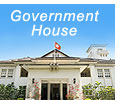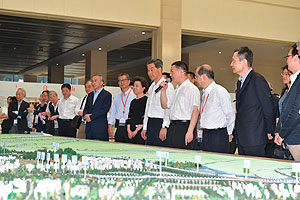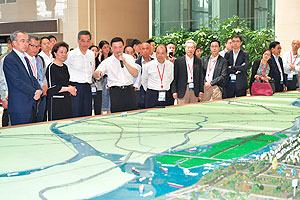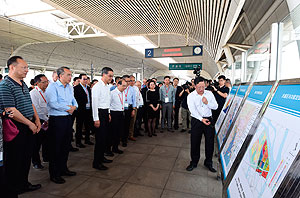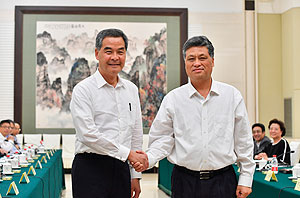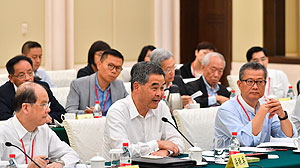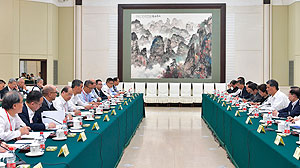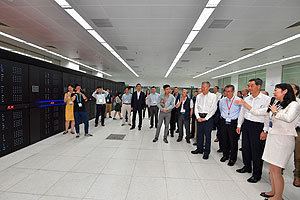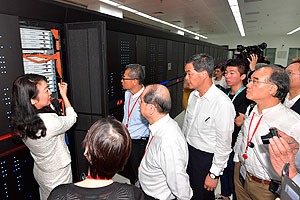
|
Visit to Guangdong-Hong Kong-Macao Bay AreaToday, I embarked on a three-day visit to the Guangdong-Hong Kong-Macao Bay Area with two Secretaries of Departments, Directors/Deputy Directors of six bureaux and other government officials, 23 non-official members of the Executive Council, members of the Commission on Strategic Development and the Economic Development Commission, as well as the media. Our visit covers six cities, namely Guangzhou, Foshan, Zhaoqing, Jiangmen, Zhongshan and Zhuhai. The Bay Area also covers Shenzhen, Dongguan and Huizhou in the east bank of the Pearl River, which are frequented by Hong Kong people, as well as the two Special Administrative Regions of Hong Kong and Macao. As a key link of the 21st-Century Maritime Silk Road, the Bay Area encompasses 11 cities with a total population of over 66 million and an economic size of more than US$1.3 trillion. The region has great potential to develop into a world-class metropolitan cluster like the Tokyo Bay Area and the San Francisco Bay Area. Our country attaches great importance and gives full support to the development of the Bay Area. The Dedicated Chapter on Hong Kong and Macao in the National 13th Five-Year Plan and the State Council's Guiding Opinions on Deepening Pan-Pearl River Delta Regional Co-operation published last year gave clear support to the development of the Bay Area. In the Hong Kong and Macao section of the Central Government's work report delivered in March this year, Premier Li Keqiang announced the launch of a joint study to prepare a development plan for the Bay Area. Hong Kong, Macao and Guangdong have been maintaining close liaison with the National Development and Reform Commission to actively take forward the planning of the Bay Area. We seek to finalise the plan within this year for the approval of the State Council. The planning objective of the Bay Area is to identify the role and positioning of each city and complement each other's strengths according to their comparative advantages, so as to enhance the competitiveness of the entire region. To better prepare ourselves and to participate in the planning work in a timely manner, the Hong Kong Special Administrative Region (HKSAR) Government organised this visit to help the delegation, the media and different sectors of the Hong Kong community get a better understanding of the Bay Area, particularly the latest developments of the cities on the west bank of the Pearl River. We spent most of the time in Guangzhou today. The delegation held a forum with the Governor of Guangdong Province, Mr Ma Xingrui, and the Guangdong Provincial Development and Reform Commission to learn more about their suggestions and views on the Bay Area development plan. Mr Ma said that the Central Authorities attached great importance to the development of the Bay Area. It is an important platform for deepening co-operation among Guangdong, Hong Kong and Macao as well as a platform for fostering the joint development of the three places. He pointed out that Hong Kong and the Mainland could enhance the transport network of the Bay Area through infrastructure projects such as the Guangzhou-Shenzhen-Hong Kong Express Rail Link (XRL) and the Hong Kong-Zhuhai-Macao Bridge. Connectivity in the flow of capital, people and goods between the Mainland and Hong Kong could also be enhanced. Mr Ma also said that Hong Kong and the Mainland should avoid homogenisation and strive to achieve synergy through complementing each other's strengths. Hong Kong could contribute to the development of the Bay Area in areas of innovation and technology, professional services and modern services. Guangdong has always been our important partner in economic and social development. For the past 30 years, Hong Kong's economic development has benefitted from the reform and opening up of Guangdong. I told the Guangdong Governor that the HKSAR Government attached great importance to the Bay Area development plan and that was why we visited with a large, high-level and broadly representative delegation. Each city in the Bay Area has its own strengths. Under "one country, two systems", Hong Kong has the advantage of being a highly international metropolis. Our systems dovetail with those of other countries in the world. We maintain close links with the international community and possess biliterate and trilingual abilities. Hong Kong can partner with the Mainland cities in tapping into the markets along the Belt and Road. In terms of economic structure, Hong Kong and the Mainland can leverage their respective strengths to achieve synergy through "staggered development". Hong Kong's high value-added services such as finance, professional services, project negotiation and management, law and dispute resolution, maritime services and international tourism are on par with international standards. We can complement the Mainland cities in these areas. We can also explore joint development in innovation and technology as well as tourism. I suggested that Guangdong and Hong Kong could discuss specifically the industries, businesses and projects in which we can enhance co-operation, as well as the modes of co-operation. Some delegation members also made suggestions for deepening the co-operation between Guangdong and Hong Kong in various areas such as finance, professional services, innovation and technology, tourism, infrastructure and urban planning. Today, the delegation also visited the Nansha Free Trade Zone Planning Exhibition Centre, the Qingsheng Interchange and the National Supercomputer Center at Sun Yat-sen University in Guangzhou. Nansha is an important harbour and a maritime hub in the region. It is developing a transport network connecting the neighbouring areas. Construction of the Shenzhen-Zhongshan Bridge has begun and the Humen 2nd Bridge project is in full swing. The Qingsheng Interchange, connecting the XRL, the metro and public transport seamlessly, is Nansha's integrated transport hub. Upon commissioning of the XRL, it will only take half an hour to travel from Qingsheng to Kowloon of Hong Kong. The National Supercomputer Center is important technological infrastructure jointly built by the Guangdong Province, the Guangzhou Municipal Government, the National University of Defense Technology and Sun Yat-sen University. The Center's supercomputer, Tianhe-2, is at the forefront of the world in terms of peak processing speed, continuous processing speed and integrated technology. It represents a landmark achievement of the country's development in supercomputing technology and Guangdong's remarkable accomplishments in scientific and technological research. April 19, 2017
|
|||||||||||||||||
|

